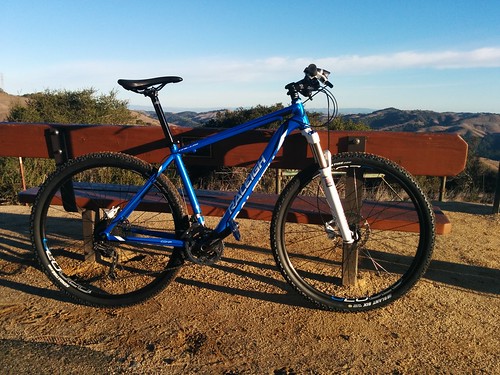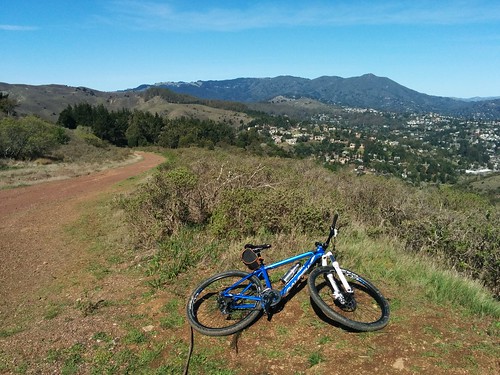"The truth is, because of some other priorities in my life right now, any major bike projects will probably wait for a year or two, so this is my stable as it will be for a while. And I'm pretty satisfied with it."
One of the things I find funny about this whole blogging thing is how once I write down how I feel about something, I kind of let go of it and my feelings quickly change. The above statement is a perfect example. Only three months or so after saying I had stabilized my stable, I had sold my Casseroll road bike and used the funds to buy my first "real" mountain bike, a Raleigh Talus 29 Comp, in size Large (19"). Quite rightly, the purchase of my first 29er coincided with my 29th birthday in early February. Here it is, my 29er for 29, in all of its glory:

This bike represents a major departure from bike business as usual, for me, being my first hands-on experience with a number of technologies:
-Aluminum frame construction. I've basically only bought steel frames until now, enjoying the durability and smooth ride. With 29x2" tires and a sprung fork (see below) on this beast, I'm not really worried about shock absorbing qualities of the frames as much.
-Suspension! Specifically, a RockShox XC 32 fork with Solo Air spring. Nothing to write home about for MTB geeks, but just quality enough and adjustable enough that I feel like I'm getting a sense of what modern suspension technology has to offer. It has a compression lockout. I use it often.
-Fully modern drivetrain with indexed "rapid fire" shifters, matched derailleurs (Shimano Deore "Shadow," meaning that the rear derailleur has a smaller lateral profile that's less likely to get smacked into rocks), and outboard bearing BB with two-piece crankset (again, Deore). So far so good on this front. I don't mind the wide Q-factor, in fact, it feels good, and I do appreciate the fact that my bearings aren't pressed into the frame, so they're easy to replace. The only problem has been a bit of front derailleur tire rub in the granny gear, which is more of a frame design or adjustment issue.
-Hydraulic Disc Brakes, specifically the Shimano BR-M395's. As far as I can tell, this is a non-series OEM brake that is roughly matching the Deore/Alivio quality of the rest of the bike.
This last one, especially, has been the biggest love/hate technology for me on this bike. In part, I bought this bike in order to give myself more experience and make myself more comfortable working on these types of technology, since I am increasingly called upon to set up and service them in my job as a mechanic. This is especially true of disc brakes, since they are rapidly becoming the norm for cargo bikes, our bread and butter at the shop where I work.

First, the love. I bought this bike because I have a burgeoning interest in off-road riding, fueled by my explorations over last summer and fall on the Trucker. And living up to my expectations, the 29er is by far the most capable off-road machine I've ever ridden, giving me much more confidence on the fire trails I had previous ridden on the Trucker, and opening up new riding opportunities on technical trails I might have thought twice about riding before. In particular, I've loved the single track in Joaquin Miller Park above Oakland, and I said this on the Rivendell list after my first ride there with some riding companions from the list:
"..,being a relative novice to technical off-road riding, I was thankful for every last ounce of tire volume, fork travel, and hydraulic fluid I had, and totally humbled by the skills of my companions on their steel all-rounders."

The hydraulic disc brakes are no small part of that. When I'm working my way down a steep and bumpy descent I feel really in control, always having the braking power I need and with the braking surface separate from the rim, never worrying about over-braking or rim damage. I feel the same way about the fat tires and the suspension fork: they let me build up speed when I'm confident, but they also let me slow down and keep my speed in check when the trail is sketchy, to take things at a pace that my novice off-road skills can keep up with.
But then, there's the hate. While the technologies on the new bike have increased my confidence as a novice off-roader while riding, as a mechanic they've taken all of my skills to get set up satisfactorily. The first few weeks of the new bike's life were marked by many multi-hour sessions in the shop, trying to get everything dialed just so. The brakes were the biggest part of this; they took a long time to where they were hitting the rotor squarely and evenly from both sides, and not rubbing when released. The standard "pull the levers with the calipers loose to self-align, then tighten caliper mounting bolts" simply didn't work, and I tried everything to get them to align properly: advancing and lubricating the pistons, pushing them back and pumping the levers to let them find their natural position, facing the mounts, etc. In the end, I got them to work, but it was a long process.
All of this reinforces something I've learned about disc brakes: when everything is spot on, they work great. However, when things are off just slightly, they don't work nearly as well. Compared, for instance, to a set of V-brakes, they have fewer means of adjustment. A hydraulic disc brake caliper has no adjustment for pad position other than the overall position of the caliper, while even the cheapest v-brakes have independent adjustments for the position and angle of each pad, not to mention the spring tension in each arm and overall cable tension. Furthermore, these adjustments have ranges of multiple centimeters, while the whole travel of disc brakes happens in fractions of millimeters. In the "less advanced technology" of v-brakes, there are built in means to deal with imperfection, and an experienced mechanic can still adjust cheap brakes to work surprisingly well. As I work with mass-produced disc brakes on mass-produced frames, I just don't find the same means to deal with the imperfections inherent in things built to certain quality-control and cost margins. That frustrates me.
All of this makes me curious to try a bike designed for off-road riding that uses simper technology. When I was describing how much control I felt off-road while on the new bike, a coworker asked, "Yeah, but how much of that is tires?" How would a bike with similarly knobby 29x2" tires, but with a rigid frame/fork and rim brakes feel off road? Is over-braking and rim damage actually a concern? However, there is almost no choice when it comes to mountain bikes in terms of braking systems, no chance to compare braking systems on the same bike. Virtually all mass-produced mountain bikes use disc brakes exclusively, and hydraulic brakes are rapidly marching down the price points. The only mass-produced 29er mountain bike frame that has mounts for both disc brakes and rim brakes, as far as I can tell, is the Surly Ogre. There are small production frames like the Rivendell Hunqapillar and upcoming Velo-Orange Camargue that use rim brakes, but with no fittings for disc brakes and more all-round-ish geometry, they are a commitment in a different direction.
There's not much out there for the the relatively novice, technologically skeptical, empirically curious off-road rider.
(Having said all this, I'll probably post a glowing endorsement of hydraulic disc brakes in a couple of months).
No comments:
Post a Comment